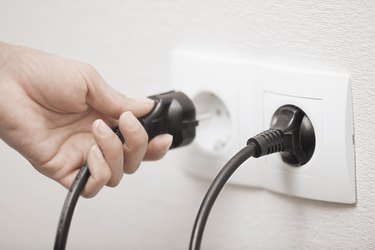
No matter what it looks like from the outside, every four-prong, 240-volt plug has the same terminal connections inside. Generator twist-lock plug wiring, for example, is no different than the wiring for a conventional four-prong plug with the same current rating. To understand how to wire a 240-volt plug, it helps to have an understanding of 240-volt electrical connections in general.
The first thing to appreciate is that 240 volts is equivalent to 250, 230 and 220 volts in the world of residential wiring. The different numbers only reflect the variability of the voltage passing through residential circuitry. Of all the possibilities, 240 volts is probably the most accurate because that is the actual voltage coming into the panel from the line transformer.
Video of the Day
Video of the Day
Basic 240-Volt Wiring
Line transformers – those large cylinders you see on the power lines – step the line voltage down from the thousands of volts necessary for transmission to 240 volts, and two wires with this voltage between them carry the electricity to residential panels. Each of these wires connects to a hot bus in the panel, and a single neutral wire, connected to a neutral bus, returns to the transformer.
The voltage between each hot bus in the panel and the neutral bus is 120 volts, which is the operating voltage for most household lights and appliances. To create a circuit with this voltage, you need a circuit breaker that contacts one of the bus bars and the neutral bus. However, larger appliances such as dryers, stoves and water heaters operate more efficiently at 240 volts. To get that voltage, you need a pair of breakers, each contacting one of the hot bus bars. The wires connected to these breakers have 240 volts between them.
These two hot wires form a closed loop, so the neutral wire isn't necessary in a 240-volt circuit. However, some 240-volt appliances have features such as clocks that run on 120-volt power, and the neutral wire is needed for these features. Finally, every circuit in the house has to be connected to the ground bus in the panel as per current National Electrical Code requirements. Every four-prong, 240-volt outlet or plug has a terminal for each of the hot wires as well as for the neutral and ground.
Wire Gauge Depends on Current Draw
Before you wire a 240-volt plug, look at its current rating, which is marked clearly on it. If the plug is rated for 20 amps, such as a NEMA L14-20, the recommended wire is 12 AWG, but if the plug is rated for 30 amps, such as a NEMA L14-30, you must upgrade to 10 AWG wire. Jump to 8 AWG for a plug rated for 40 amps and to 6 AWG for a plug rated for 50 amps. These wire gauge specifications apply to both twist-lock and conventional plugs.
Thicker wires are difficult to wrap around terminal screws. The recommended way to fasten them is to crimp a ring lug onto each one and secure the lug to the terminal screw.
How to Wire a Twist-Lock Plug
When you loosen the screws to separate the plug, you'll see the four terminal screws in the front part of the housing. The two brass ones are for the hot wires, which are the red and black wires in a three-conductor cable. The red and black wires are interchangeable between the two brass screws. The chrome terminal is for the white neutral wire, and the green terminal is for the bare ground wire.
Strip 1/2 inch from the end of each insulated wire in the cable, crimp a ring lug onto the end of each wire and connect the wires to the terminal screws. Reassemble the plug housing and tighten the wire clamp on the end of the plug, and the plug is ready for use.